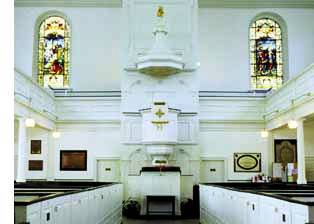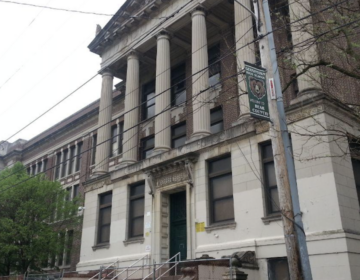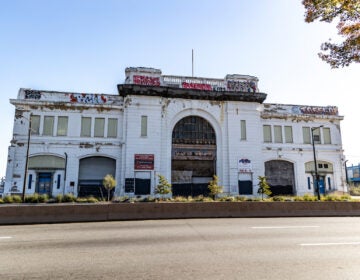St. Peter’s Q&A

ST. PETER’S EPISCOPAL Q&A
Respondent: Rev. Richard L. Ullmann
1. St. Peter’s was the home church of Bishop White, one of the founders of the American Episcopal Church following our independence from Great Britain. A National Historic Landmark, it played a pivotal role in Philadelphia life during the Colonial period and the Early Republic. What is your congregation’s role in the history of the waterfront? How does this the congregation’s history, building and place illustrate the role of the Episcopal Church in Philadelphia? What challenges has it faced?
While the wealthier members of St. Peter’s lived west and north of the church, most of those referred to as the artisan class (including dockworkers and those associated with the trades and the Dock Street Market) lived in the blocks between Second Street and the waterfront south and east. The post Civil War era found active missionary work by priests and church members, mostly the women led by Ann Wharton Lewis Glen. Church rolls increased, services designed for the working classes added, and a series of four St. Peter’s Houses, designed at first for widows and their children and so-called fallen women were opened in succession, including one at Second and Lombard and one on Fitzwater between Front and Second – right in the heart of Southwark, where the dockworkers were concentrated. In the heart of waterfront neighborhoods, incorporating the Coleman and Welsh properties at Front and Pine, was the most active of the St. Peter’s Houses (1870-1923), which included a savings bank, manual trade school, chapel, a summer school primarily for Russian Jewish immigrant children to “Americanize them”. A series of charity funds channeled parishioner donations to help pay for services. St. Peter’s House worked closely with Protestant Episcopal City Mission (today’s Episcopal Community Services) and Episcopal Hospital to provide medical care. Rats from the docks, the poultry plants, and Dock Street market undermined the building, so St. Peter’s House moved to 313 Pine, although the church continued to operate a cafeteria for dockworkers to provide free lunches after Prohibition closed the saloons in 1919. By 1937, public schools and government agencies assumed many of the services that had been the focus of St. Peter’s outreach ministries, so most St. Peter’s House activities were curtailed.
2. How has your congregational make-up and ministry evolved over the past fifty years? What sorts of people attend services at St. Peter’s and where do they come from? What has drawn them to this church in particular?
The past fifty years saw first decline, then growth. For the last twenty years, growth has stretched our facilities to the limit. When the church was in decline (from about 1950, when there was pressure to merge the congregation with Christ Church), much of our property was either sold or leased to St. Peter’s School, which has been a nonprofit entity independent of the church for almost forty years.
Most of St. Peter’s members live in walking distance of the church. Most are well educated, and many are affluent, although some are young professionals just starting out who are not so well off. They come from within Society Hill, but also from Queen Village, Old City, New Jersey and more distant neighborhoods. They have been drawn by the church’s hospitality, history, progressive programming, and emphasis on spiritual and intellectual growth – and certainly also by the leadership team of staff and volunteers that has evolved under the direction of our Rector, the Rev. Ledlie Laughlin.
3. What are some of your thoughts about how Society Hill has evolved in recent years, especially how the neighborhood has been transformed into one of the city’s most fashionable residential districts? How has this affected your church’s mission and congregation?
The way Society Hill and neighboring Old City, Washington Square West, Queen Village and Bella Vista have evolved in recent years has created a vibrant urban environment attractive to a broad range of people. They, in turn, bring energy, vitality, and diversity to our congregational life, so that our community now includes singles, young families in formation, and empty-nesters; lifetime Philadelphians, ex-suburbanites, and transplants from other states and nations; religious traditionalists, spiritual seekers, and those who are simply curious. All of this has resulted in enriched and expanded programs: children’s choirs, educational ventures, variety in liturgy, growth in outreach, and much more.
As all of this has evolved over the last twenty years, we have operated a food cupboard that serves 120 people every Saturday morning, primarily elderly people (55 percent of them Chinese). In addition, the homeless share our Churchyard with neighbors, tourists, and dog-walkers, and wander our neighborhood in ever-increasing numbers.
4. What are your feelings about the proposed waterfront developments, not just casinos but also residential and commercial. How do you feel these will affect your ministry and your church?
The residential and commercial development of recent years has brought noticeable change in the demographics around the church, in particular many more young families with young children. Our ministries have reflected that change, with expanded church school, childcare, children’s worship, parenting café, etc.
If the Foxwoods casino goes forward as currently proposed, St. Peter’s is likely to suffer from the resulting traffic congestion. The predictable adverse social effects of gambling addiction and property crimes in neighborhoods near casinos will certainly have long-term (and presently unpredictable) impact on both membership and outreach ministries.
5. What do you see as the future of St. Peter’s?
Our near future is bright. We are blessed with a wonderful, dynamic community of the faithful at St. Peter’s. Should all the negatives that can come with casinos take place, we may see a decline in the neighborhood as people flee. This obviously would have terrible consequences for St. Peter’s.
6. How has the construction of I-95 affected your congregation?
I-95 destroyed a considerable portion of the older neighborhoods along the waterfront from which much of St. Peter’s artisan class membership came. Still, those who were scattered to the Northeast and the South by that construction used the highway to regularly attend services. Those folks have pretty much died off. Long-term result: I-95 has isolated our neighborhood and made our congregation less diverse than it had been.
7. In a sentence, what does the phrase “Holy Experiment” mean to you in 2007?
William Penn was both a man of the world – a privileged member of the landed gentry within a mighty empire – and a visionary far ahead of his time. He hoped to increase his wealth by selling land from the enormous grant King Charles II settled upon him. He also intended to govern this great territory in such as way “that an example may be set up to the nations as… a holy experiment’.
Settlers in Pennsylvania enjoyed unprecedented religious freedom and unprecedented self-government. Penn’s example did, indeed, set up an example to the nations. His principles of government underlie our national constitution.
Penn’s vision still inspires. A key element of his Holy Experiment was to delegate governmental decisions to the lowest practicable level. The importance of that principle becomes most apparent when government makes decisions without transparency, in the absence of citizen input. The present energy of Philadelphia’s riverfront neighborhoods to have defining influence on riverfront development is a clear example of the vitality of Penn’s vision.
WHYY is your source for fact-based, in-depth journalism and information. As a nonprofit organization, we rely on financial support from readers like you. Please give today.






